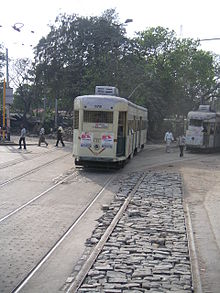- Tram transport in India
-
Tram transport in India, as of 2011, is limited to Kolkata (formerly Calcutta). In the past, Mumbai (Bombay), Delhi, Patna, Kanpur (Cawnpore), Chennai and Nasik have had tram service.
Contents
Kolkata
Main article: Calcutta Tramways CompanyThe Calcutta Tramways Company, Limited is the company which manages tramways in Kolkata. Horse-drawn tram service was begun on 24 February 1873 between Sealdah and Armenian Ghat Street; due to inadequate ridership, the service ended on November 20 of that year. The British registered the Calcutta Tramways Company, Limited as a joint stock company in London in 1880. Before 1900, the trams were horse-drawn; that year, the process of electrification began.
In 1951 the government of West Bengal entered into an agreement with the CTC, and the Calcutta Tramways Act was enacted. The government took over all rights regarding the tramways; it reserved the right to purchase the system on 1 January 1972 or any time thereafter, with two years' notice. In 1967 the government of West Bengal passed the Calcutta Tramways Company (Taking Over of Management) Act, and assumed its management on 19 July 1967. On 8 November 1976 the Calcutta Tramways (Acquisition of Undertaking) Ordinance was enacted, under which the company vested all its assets with the government; it is now a public-sector undertaking.[1]
Mumbai
The British proposed the introduction of trams in 1864, and the contract was awarded to Stearns and Kitteredge in 1873. The first tram, begun between Parel and Colaba on 9 May 1874, were drawn by six to eight horses )Stearns and Kitteredge reportedly had a stable of 900 horses when tram service began). Electrified tram service began on 7 May 1907. Double-deck tram service began in September 1920; at the peak of service in 1935, 433 trams ran on 47 kilometres (29 mi) of track. The trams met travelers' needs until the advent of trains; the service closed on 31 March 1964.[2]
Delhi
Delhi's tram system opened on 6 March 1908. At its zenith in 1921 there were 24 open cars utilising 15 km of track. The system was in operation until about 1963.[2]
Patna
Patna was among the few cities in India having horse-drawn trams as urban transport[3] The horse-drawn tram in Patna ran in the populated stretch of Ashok Rajpath, from Patna City to Bankipore, with its western terminus at Sabzibagh (opposite Pirbahore Police Station) under the direction of the Patna City Municipality. The tram was discontinued in 1903 due to lack of ridership; plans to extend it further west never materialised.
Kanpur
Trams were introduced in Kanpur in June 1907. The introductory stock was electric traction-type single-coach; single-coach trams were also used in Delhi, Mumbai and Chennai. There was one line – a four-mile stretch between the train station and Sirsaya Ghat, on the Ganges – and 20 open cars. Service was discontinued on 16 May 1933.[2]
Nasik
This tramway was constructed in 1889 to a gauge of 2 ft 6 in (762 mm). The consulting engineer was Everard Calthrop, who later achieved renown with the Barsi Light Railway. Originally, the tramway used two carriages pulled by four horses; petrol-driven railcars were introduced in 1916.
It originated from what is now the Old Municipal Corporation building located on Main Road, and terminated at the Nasik Road railway station (a distance of around 8–10 km). The stretch between Nasik and Nasik Road was covered with dense jungle; the only mode of transport from the station to the city was by horse-drawn carriage or one of two taxis. The tramway closed down between 1931 and 1933.
Chennai
Trams in Chennai (formerly Madras) were operated between the docks and the inland areas, carrying goods and passengers. When the system began on 7 May 1895, it was the first electric tram system in India. The trams could carry heavy loads and were popular, with thousands of riders daily. The route encompassed Mount Road, Parrys Corner, Poonamallee Road and the Ripon Building. At its height in 1921, there were 97 cars running on 24 km of track. However, the tram company went bankrupt about 1950 and the system closed on 12 April 1953.[2] The contract to remove the tracks and overhead cables was given to Narainsingh Ghanshamsingh.
Power supply
The trams were run on a direct current power supply from overhead power lines, which replaced the original conduit after a series of monsoons. The power supply was obtained by a current collector called a trolley pole, mounted on top of the tram. The track rails served as the return path for the DC current.
The DC power was supplied by mercury arc rectifier (converter) stations located in various sections of Chennai. Power for them was supplied by the Madras Electricity System, from a thermal power station at Basins Bridge which generated AC power.
References
- ^ Calcutta Tramways Comapany timeline Retrieved 2011-03-16.
- ^ a b c d Tram views of Asia Retrieved 2011-03-16.
- ^ "First-ever book on Patna soon". The Times of India, September 23, 2008 Retrieved 2011-03-16.
External links
Wikimedia Foundation. 2010.


